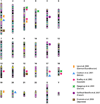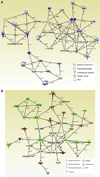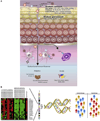An update on the genetics of atopic dermatitis: scratching the surface in 2009
- PMID: 20109730
- PMCID: PMC2874322
- DOI: 10.1016/j.jaci.2009.11.008
An update on the genetics of atopic dermatitis: scratching the surface in 2009
Abstract
A genetic basis for atopic dermatitis (AD) has long been recognized. Historic documents allude to family history of disease as a risk factor. Before characterization of the human genome, heritability studies combined with family-based linkage studies supported the definition of AD as a complex trait in that interactions between genes and environmental factors and the interplay between multiple genes contribute to disease manifestation. A summary of more than 100 published reports on genetic association studies through mid-2009 implicates 81 genes, in 46 of which at least 1 positive association with AD has been demonstrated. Of these, the gene encoding filaggrin (FLG) has been most consistently replicated. Most candidate gene studies to date have focused on adaptive and innate immune response genes, but there is increasing interest in skin barrier dysfunction genes. This review examines the methods that have been used to identify susceptibility genes for AD and how the underlying pathology of this disease has been used to select candidate genes. Current challenges and the potential effect of new technologies are discussed.
Copyright 2010 American Academy of Allergy, Asthma & Immunology. Published by Mosby, Inc. All rights reserved.
Figures





Similar articles
-
The Genetics and Epigenetics of Atopic Dermatitis-Filaggrin and Other Polymorphisms.Clin Rev Allergy Immunol. 2016 Dec;51(3):315-328. doi: 10.1007/s12016-015-8508-5. Clin Rev Allergy Immunol. 2016. PMID: 26385242 Review.
-
Genetics of atopic dermatitis.J Dtsch Dermatol Ges. 2011 Sep;9(9):670-6. doi: 10.1111/j.1610-0387.2011.07656.x. Epub 2011 Apr 26. J Dtsch Dermatol Ges. 2011. PMID: 21518425 Review. English, German.
-
Unravelling the complex genetic background of atopic dermatitis: from genetic association results towards novel therapeutic strategies.Arch Dermatol Res. 2015 Oct;307(8):659-70. doi: 10.1007/s00403-015-1550-6. Epub 2015 Feb 19. Arch Dermatol Res. 2015. PMID: 25693656 Review.
-
Genetics of Atopic Dermatitis: From DNA Sequence to Clinical Relevance.Dermatology. 2019;235(5):355-364. doi: 10.1159/000500402. Epub 2019 Jun 14. Dermatology. 2019. PMID: 31203284 Review.
-
Genetics in Atopic Dermatitis: Historical Perspective and Future Prospects.Acta Derm Venereol. 2020 Jun 9;100(12):adv00163. doi: 10.2340/00015555-3513. Acta Derm Venereol. 2020. PMID: 32412647 Free PMC article. Review.
Cited by
-
Resolving the etiology of atopic disorders by using genetic analysis of racial ancestry.J Allergy Clin Immunol. 2016 Sep;138(3):676-699. doi: 10.1016/j.jaci.2016.02.045. Epub 2016 Jun 11. J Allergy Clin Immunol. 2016. PMID: 27297995 Free PMC article. Review.
-
Hataedock Treatment Has Preventive Therapeutic Effects in Atopic Dermatitis-Induced NC/Nga Mice under High-Fat Diet Conditions.Evid Based Complement Alternat Med. 2016;2016:1739760. doi: 10.1155/2016/1739760. Epub 2016 May 24. Evid Based Complement Alternat Med. 2016. PMID: 27313639 Free PMC article.
-
Atopic dermatitis in West Highland white terriers is associated with a 1.3-Mb region on CFA 17.Immunogenetics. 2012 Mar;64(3):209-17. doi: 10.1007/s00251-011-0577-x. Epub 2011 Oct 12. Immunogenetics. 2012. PMID: 21989516
-
An Overview of the Latest Metabolomics Studies on Atopic Eczema with New Directions for Study.Int J Mol Sci. 2022 Aug 8;23(15):8791. doi: 10.3390/ijms23158791. Int J Mol Sci. 2022. PMID: 35955924 Free PMC article. Review.
-
Genome-wide association study identifies two new susceptibility loci for atopic dermatitis in the Chinese Han population.Nat Genet. 2011 Jun 12;43(7):690-4. doi: 10.1038/ng.851. Nat Genet. 2011. PMID: 21666691
References
-
- Smith WD. Hippocrates. Cambridge, MA: Harvard University Press; 1994.
-
- Besnier E. Premier note et observations preliminaire pour service d-introduction a letute des prurigos diathesiques. Ann Dermatol Syphil. 1892;3:634–638.
-
- Coca AF. Specific Diagnosis and Treatment of Allergic Diseases of the Skin. JAMA. 1934;103(17):1275–1277.
-
- Sneddon IB. The management of infantile eczema. Vol. 226. Medical Press; 1951. pp. 329–333. - PubMed
Publication types
MeSH terms
Substances
Grants and funding
LinkOut - more resources
Full Text Sources
Other Literature Sources
Miscellaneous

